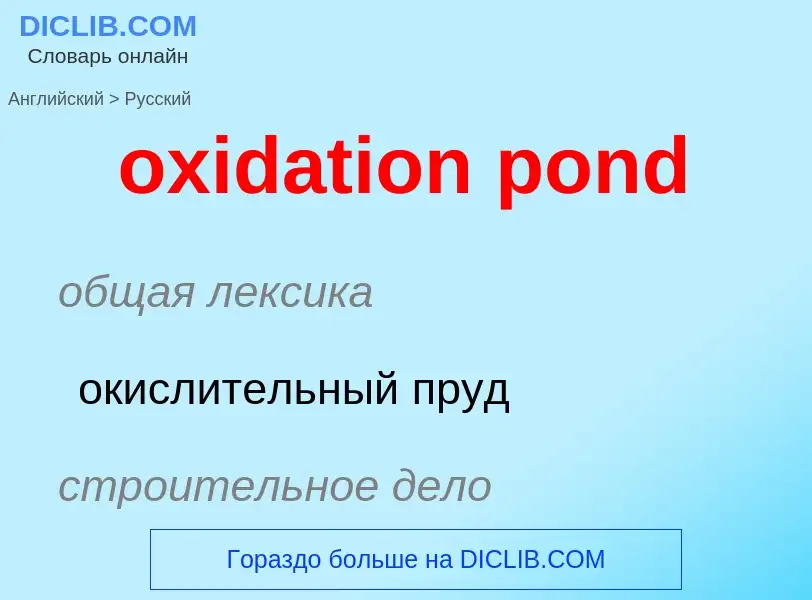Vertaling en analyse van woorden door kunstmatige intelligentie
Op deze pagina kunt u een gedetailleerde analyse krijgen van een woord of zin, geproduceerd met behulp van de beste kunstmatige intelligentietechnologie tot nu toe:
- hoe het woord wordt gebruikt
- gebruiksfrequentie
- het wordt vaker gebruikt in mondelinge of schriftelijke toespraken
- opties voor woordvertaling
- Gebruiksvoorbeelden (meerdere zinnen met vertaling)
- etymologie
oxidation pond - vertaling naar russisch
общая лексика
окислительный пруд
строительное дело
окислительный пруд (с искусственной аэрацией)
строительное дело
стабилизационный пруд
Definitie
Wikipedia
Waste stabilization ponds (WSPs or stabilization ponds or waste stabilization lagoons) are ponds designed and built for wastewater treatment to reduce the organic content and remove pathogens from wastewater. They are man-made depressions confined by earthen structures. Wastewater or "influent" enters on one side of the waste stabilization pond and exits on the other side as "effluent", after spending several days in the pond, during which treatment processes take place.
Waste stabilization ponds are used worldwide for wastewater treatment and are especially suitable for developing countries that have warm climates. They are frequently used to treat sewage and industrial effluents, but may also be used for treatment of municipal run-off or stormwater. The system may consist of a single pond or several ponds in a series, each pond playing a different role in the removal of pollutants. After treatment, the effluent may be returned to surface water or reused as irrigation water (or reclaimed water) if the effluent meets the required effluent standards (e.g. sufficiently low levels of pathogens).
Waste stabilization ponds involve natural treatment processes which take time because removal rates are slow. Therefore, larger areas are required than for other treatment processes with external energy inputs. Waste stabilization ponds described here use no aerators. High-performance lagoon technology that does use aerators has much more in common with the activated sludge process. Such aerated lagoons use less area than is needed for traditional stabilization ponds and are also common in small towns.

![Kariba]], Zimbabwe (sludge needs to be removed) Kariba]], Zimbabwe (sludge needs to be removed)](https://commons.wikimedia.org/wiki/Special:FilePath/Anaerobic treatment pond (6910359715).jpg?width=200)

![Facultative pond in Ruai, [[Kenya]] Facultative pond in Ruai, [[Kenya]]](https://commons.wikimedia.org/wiki/Special:FilePath/Facultative pond (6898412198).jpg?width=200)
![Effluent from a high rate [[algae]] pond and two maturation ponds in Attaouia, [[Morocco]]. Note the green color, caused by algae. Effluent from a high rate [[algae]] pond and two maturation ponds in Attaouia, [[Morocco]]. Note the green color, caused by algae.](https://commons.wikimedia.org/wiki/Special:FilePath/Réutilisation à Attaouia effluent utilisé (11323854204).jpg?width=200)
![Waste stabilization pond at Grand [[Agadir]], [[Morocco]] (Station M’zar) Waste stabilization pond at Grand [[Agadir]], [[Morocco]] (Station M’zar)](https://commons.wikimedia.org/wiki/Special:FilePath/Traitement des Eaux usées de l’agglomération du Grand Agadir - Station M’zar - Traitement secondaire (bassin de lagunage) (11116683716).jpg?width=200)
![Ceara]], Brazil Ceara]], Brazil](https://commons.wikimedia.org/wiki/Special:FilePath/Waste stabilization ponds facultative pond (in Brazil).png?width=200)
